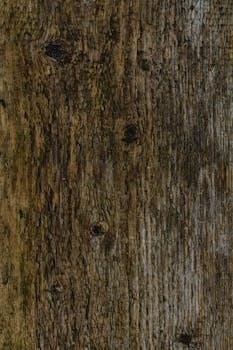Paracord Knots⁚ A Comprehensive Guide
Paracord knots are essential skills for crafting items like bracelets, keychains, and lanyards. Understanding these knots unlocks a world of possibilities. This guide provides a comprehensive overview, detailing essential knots, projects, and expert tips. From beginner-friendly knots to advanced techniques, explore the art of paracord knotting.
What is Paracord?
Paracord, short for parachute cord, is a lightweight nylon rope initially used in the suspension lines of parachutes. Its robust construction and versatility have made it a popular material for various applications beyond its original purpose. Typically, paracord consists of a braided outer sheath surrounding multiple inner strands or yarns. These inner strands contribute to the cord’s overall strength and can be removed and used separately in survival situations for tasks like fishing line or sewing thread.
The outer sheath provides abrasion resistance and protects the inner core, making paracord exceptionally durable. Its high strength-to-weight ratio makes it ideal for uses where a strong and reliable rope is needed without adding excessive bulk. Paracord comes in different types, with the most common being Type III, also known as 550 paracord, indicating a minimum breaking strength of 550 pounds.
Beyond its strength, paracord’s availability in various colors and patterns has contributed to its popularity in crafting and DIY projects. It’s widely used for making bracelets, keychains, lanyards, and other decorative items. Whether for practical applications or creative projects, paracord’s unique combination of strength, durability, and versatility makes it a valuable resource.
Paracord Characteristics and Applications
Paracord boasts a unique blend of characteristics that make it incredibly versatile. Its lightweight nature, coupled with exceptional strength, makes it ideal for various applications. The braided nylon construction ensures durability and resistance to abrasion, extending its lifespan even in harsh conditions. The inner strands, typically seven to nine in number for Type III paracord, can be extracted for finer tasks, adding to its utility.
The applications of paracord are extensive. In survival situations, it can be used for building shelters, creating traps, securing gear, and as a makeshift tourniquet. Its strength makes it suitable for towing light loads and repairing equipment. Outdoors enthusiasts use it for camping, hiking, and climbing. Paracord’s water resistance and quick-drying properties are advantageous in wet environments.
Beyond practical uses, paracord is popular in crafting. Its availability in numerous colors and patterns allows for creative expression in making bracelets, keychains, lanyards, and dog collars. The ability to tie various knots adds to its versatility, enabling intricate designs and functional closures. Whether for emergency preparedness, outdoor adventures, or creative projects, paracord’s unique characteristics make it an indispensable tool and material.
Essential Paracord Knots for Beginners
For those venturing into the world of paracord crafting, mastering a few essential knots is crucial. These foundational knots provide the basis for numerous projects and enhance your ability to utilize paracord effectively. The overhand knot, a simple loop secured by passing the end through, serves as a basic stopper knot, preventing fraying and slippage. The square knot, formed by interlacing two ropes, is ideal for joining two ends together.
The sheet bend, similar to the square knot but more secure, excels at connecting ropes of different thicknesses. The bowline creates a reliable loop that won’t slip or tighten under tension, making it perfect for rescue situations or securing items. The clove hitch provides a secure way to attach a rope to a pole or ring. These knots are relatively easy to learn and form the backbone of many paracord projects.
Practicing these essential knots will build your confidence and dexterity. Visual guides and tutorials can greatly aid the learning process. As you become more comfortable, you can explore more complex knots and braiding techniques. Mastering these basic knots opens the door to a wide range of paracord crafts and practical applications, making them invaluable for any beginner.
Lanyard Knot Tutorial
The lanyard knot, a decorative and functional knot, is commonly used to create loops for attaching keys, knives, or other small items. This tutorial provides a step-by-step guide to tying a secure and aesthetically pleasing lanyard knot. Start by folding the paracord in half, creating a loop at the center. Bring the ends down and pass them through the loop, forming a basic overhand knot.
Next, create a series of interlocking loops with the two ends of the paracord. These loops should be neatly arranged and tightened gradually to form the desired shape. The number of loops can be adjusted to create a thicker or more intricate knot. Once the loops are formed, carefully tighten the knot, ensuring that all strands are evenly tensioned.
The final step involves trimming the excess paracord and melting the ends to prevent fraying. The lanyard knot can be customized with different colors and patterns to create unique and personalized accessories. This knot is relatively easy to learn and adds a touch of style and functionality to everyday items. By following this tutorial, you can master the lanyard knot and create your own paracord lanyards with confidence.
Monkey’s Fist Knot
The monkey’s fist knot is a weighted knot traditionally used by sailors to throw a line between ships or from ship to shore. Today, it is often used as a decorative element or as a self-defense tool. This tutorial will guide you through the process of creating a sturdy and well-formed monkey’s fist knot using paracord.
Begin by wrapping the paracord around your fingers several times, creating a small bundle. The number of wraps will determine the size of the knot. Next, carefully remove the bundle from your fingers and wrap the paracord around the bundle in a perpendicular direction. Repeat this process several times, alternating directions to create a spherical shape.

Once the desired shape is achieved, carefully tuck the end of the paracord back through the knot, securing it in place. The knot can be tightened gradually to create a firm and compact sphere. For added weight, a small steel ball bearing or other heavy object can be inserted into the center of the knot before tightening. The monkey’s fist knot is a challenging but rewarding knot to learn, offering both practical and aesthetic applications. With practice, you can create impressive monkey’s fist knots for a variety of purposes.
Snake Knot
The snake knot, also known as the cobra stitch, is a versatile and visually appealing knot commonly used in paracord projects like bracelets, lanyards, and keychains. Its distinctive woven pattern resembles the scales of a snake, making it a popular choice for decorative and functional items. This tutorial will guide you through creating a neat and consistent snake knot.
Start with a base cord or loop where you want to begin your snake knot. Take two strands of paracord and position them so they cross each other over the base cord. Bring the right strand over the base cord and under the left strand. Then, bring the left strand under the base cord and up through the loop created by the right strand.

Tighten the knot by pulling both strands evenly. Repeat this process, alternating which strand goes over and under, to create the snake-like pattern. Maintain consistent tension to ensure a uniform and attractive knot. The snake knot can be continued for any desired length, making it suitable for various projects. Once you reach the end, secure the strands by trimming and melting the ends or tucking them back into the knot. Mastering the snake knot opens up a wide range of creative possibilities for paracord enthusiasts.
Paracord Bracelet Tutorials⁚ Knot and Loop Closures
Paracord bracelets are popular accessories, often incorporating practical closures. Knot and loop closures offer a secure and adjustable way to fasten these bracelets; Several knot variations can be used to create this closure, each providing a unique aesthetic and level of security. This section explores tutorials for crafting paracord bracelets using knot and loop systems.
One common method involves creating a loop at one end of the bracelet using a simple overhand knot or a more decorative knot like a lanyard knot. At the other end, a knot, such as a diamond knot or a button knot, is tied. The knot passes through the loop, securing the bracelet. The size of the loop and the knot can be adjusted to achieve the desired fit.
Another approach uses sliding knots. Two adjustable loops are created, allowing the wearer to tighten or loosen the bracelet by sliding the knots along the paracord. This method offers a high degree of adjustability. Visual tutorials often demonstrate step-by-step instructions for tying these knots and integrating them into bracelet designs. Exploring different knot and loop closure techniques allows for customization and ensures a comfortable and secure fit for any paracord bracelet.
King Cobra Paracord Knot
The King Cobra paracord knot is a visually striking and robust weave, often used to create wider, more substantial paracord bracelets and other decorative items. It is essentially an enhanced version of the standard Cobra stitch, adding an extra layer of paracord for increased thickness and a bolder appearance. This knot provides a satisfyingly tactile feel and showcases the paracord’s durability.
To tie the King Cobra knot, one first needs to create a foundation, typically a length of paracord secured with a buckle or tied in a loop. The Cobra stitch is then worked along the foundation, creating a base layer. After completing the initial Cobra weave, a second layer of Cobra stitches is woven over the first, effectively doubling the width and thickness of the band.
This second layer interlocks with the first, creating a tight and secure structure. The color combinations achievable with the King Cobra knot are virtually limitless, allowing for intricate and personalized designs. Its impressive size and rugged construction make it a popular choice for survival bracelets, gear straps, and decorative accents. Tutorials often highlight the importance of maintaining consistent tension throughout the weaving process to ensure a uniform and aesthetically pleasing result. Mastering the King Cobra knot opens up a range of creative possibilities for paracord enthusiasts.
Paracord Lanyard Knot⁚ Easiest Tutorial
Creating a paracord lanyard knot is a simple yet effective way to add a personalized touch to keychains, knives, or other everyday carry items. Numerous tutorials cater to beginners, guiding them through the process of tying a secure and stylish lanyard knot with ease. The triangle lanyard knot, is a popular choice due to its straightforward construction.
Typically, these tutorials emphasize clear, step-by-step instructions, often accompanied by visual aids like diagrams or videos. One common method involves creating a series of loops and weaves with the paracord, carefully tightening and adjusting them to form the desired knot shape. The goal is to achieve a balanced and symmetrical design that is both functional and aesthetically pleasing. The snake knot is another option for creating lanyards.
Many tutorials also offer variations and embellishments, allowing users to customize their lanyards with different colors, patterns, or decorative elements. Whether you’re looking to create a basic lanyard for practical use or a more elaborate design for personal expression, the abundance of easy-to-follow tutorials makes it accessible to anyone. Mastering the fundamental techniques opens the door to creating a wide range of paracord lanyards for various applications. The key is to practice and experiment with different approaches to find what works best for your individual style and needs.
Paracord Zipper Pulls
Paracord zipper pulls are a practical and stylish way to enhance the functionality and appearance of bags, jackets, and other items with zippers. These small additions can make it easier to grip and manipulate zippers, especially when wearing gloves or in cold weather. Moreover, they offer an opportunity to personalize your gear with different colors, patterns, and knot designs.
Creating paracord zipper pulls is a simple and rewarding project that requires minimal materials and tools. Typically, you’ll need a length of paracord, a pair of scissors, and a lighter or heat source to seal the ends of the cord. A variety of knots can be used to create zipper pulls, ranging from basic overhand knots to more intricate designs like the snake knot or the diamond knot.
Many tutorials online provide step-by-step instructions and visual guides for tying different types of paracord zipper pulls. These tutorials often include tips on how to create a secure loop for attaching the pull to the zipper, as well as how to customize the length and style of the pull to suit your preferences. Additionally, you can add beads, charms, or other embellishments to further personalize your zipper pulls. With a little practice, you can create a collection of unique and functional paracord zipper pulls that reflect your individual style.

Common Mistakes and Professional Tips
When working with paracord knots, beginners often encounter common mistakes that can compromise the strength and appearance of their projects. One frequent error is tying knots too loosely, resulting in a flimsy and unreliable structure. Conversely, overtightening knots can make them difficult to adjust or untie later on. Achieving the right balance is crucial for creating durable and functional paracord items.

Another common mistake is failing to properly melt and seal the ends of the paracord after cutting. This prevents fraying and ensures a clean, professional finish. Additionally, using the wrong type of knot for a specific application can lead to failure or instability. It’s essential to research and select knots that are appropriate for the intended purpose.
Professional tips for paracord knotting include using high-quality paracord from reputable suppliers. This ensures consistent strength and durability. Furthermore, practicing knots repeatedly will improve muscle memory and accuracy. Utilizing specialized tools like knotting boards and fid needles can also enhance precision and efficiency. Finally, consulting with experienced paracord crafters and seeking feedback on your work can help identify areas for improvement and refine your technique. By avoiding common mistakes and implementing professional tips, you can elevate your paracord knotting skills and create impressive, long-lasting projects.
Paracord Projects⁚ Bracelets, Keychains, and More
Paracord’s versatility lends itself to a vast array of exciting projects, catering to both beginners and experienced crafters. Bracelets are a popular starting point, offering opportunities to experiment with various knots and color combinations. The King Cobra braid, with its robust and visually appealing design, is a favorite choice for bracelets. Other options include the Solomon bar and chain link designs, each providing a unique aesthetic.
Keychains are another excellent project for utilizing paracord skills. Simple lanyard knots can be transformed into stylish and functional keychains, while more intricate designs like the monkey’s fist add a touch of personality. Paracord zipper pulls are a practical way to enhance the functionality of bags, jackets, and other items. These can be customized with different knots and colors to match personal preferences.
Beyond bracelets, keychains, and zipper pulls, paracord can be used to create a wide range of other projects. Dog collars, lanyards, and even decorative items like plant hangers can be crafted with paracord. The possibilities are truly endless, limited only by imagination and skill. As you gain experience, you can explore more complex projects and develop your own unique designs. Paracord projects are not only enjoyable to create but also offer practical and durable solutions for everyday needs.
Paracord Knots Instructions⁚ Visual Guides
Mastering paracord knots often requires more than just written instructions. Visual guides, such as diagrams, illustrations, and videos, can significantly enhance the learning process. These visual aids provide a clear and step-by-step demonstration of each knotting technique, making it easier to understand and replicate.
Diagrams and illustrations offer a static representation of the knotting process, highlighting key steps and critical points. They are particularly useful for beginners who prefer to learn at their own pace, carefully studying each stage of the knot formation. Many online resources and paracord knotting books provide detailed diagrams for a wide range of knots.
Video tutorials take visual learning to the next level, offering a dynamic and interactive demonstration of each knot. These videos often include close-up shots, slow-motion replays, and verbal explanations, ensuring that even the most complex knots can be understood. Platforms like YouTube host countless paracord knotting tutorials, catering to various skill levels and project types.
Whether you prefer diagrams, illustrations, or videos, visual guides are an invaluable tool for mastering paracord knots. By combining these visual aids with practice and patience, you can quickly develop the skills needed to create a wide range of paracord projects. Remember to start with simpler knots and gradually progress to more complex techniques as you gain experience.